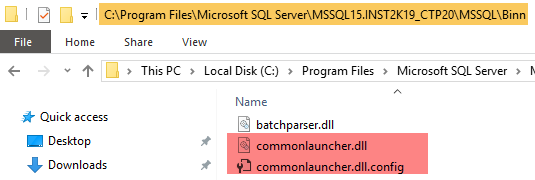If you read my roundup for week 38, which I published yesterday, you probably noticed that MS Ignite started today. I mentioned in the post that I was particularly interested in some of the SQL Server sessions, as they looked very interesting.
However, even before the sessions started, Microsoft released SQL Server 2019 CTP 2.0 for public preview and, naturally, I jumped on the download link and started downloading. I managed to get to the link in time before the rest of the world started the download, so I managed to get it down and then did an install.
The rest of this post is about my initial findings mostly in the SQL Server Machine Learning Services space.
NOTE: I have looked at SQL Server 2019 the grand total of an hour, so this is a short post.
Installation & Versions
First of all, the installation took forever, at least it felt that way. I believe it took around an hour, just for the install. So if you install, make sure you are not in a hurry.
I chose to install R and Python services in-database. After the installation finished, (finally), I enabled the machine learning services:
|
|
Code Snippet 1: Enable External Scripts
After executing the code in Code Snippet 1, I restarted the SQL Server 2019 instance, and then executed my regular “check everything works” code:
|
|
Code Snippet 2: Test Code
As you see, the code is exceptionally advanced (not), but at least the code indicates if there are any issues. The last two sp_execute_external_script statements return the R and Python versions. For R the engine is now running on version 3.4.4 whereas in SQL Server 2017 it is 3.3.3. For Python, it is the same version in both 2017 and 2019: 3.5.2.
Extensibility Framework
So, when I read
What’s new in SQL Server 2019, I came across a lot of interesting “stuff”, but one thing that stood out was Java language programmability extensions. In essence, it allows us to execute Java code in SQL Server by using a pre-built Java language extension! The way it works is as with R and Python; the code executes outside of the SQL Server engine, and you use sp_execute_external_script as the entry-point.
I haven’t had time to execute any Java code as of yet, but in the coming days, I definitely will drill into this. Something I noticed is that the architecture for SQL Server Machine Learning Services has changed (or had additions to it). If you remember from my
SQL Server Machine Learning Services posts, the flow when executing sp_execute_external_script looked something like so:
- We execute
sp_execute_external_script. - SQL Server connects to the Launchpad service.
- Based on the
@languageparameter, Launchpad calls into eitherrlauncher.dllorpythonlauncher.dll. - The respective launcher then launches the external engine.
If now Java is supported is there also a Java launcher? No, as it turns out, there is not, at least not what I could find. However what I did find was this:

Figure 1: Common Launcher
In the same directory as the R and Python launchers, I see this new commonlauncher.dll together with a config file. When looking at the config file I did not see anything giving any hints to what goes on, but - as I said above - I will investigate.
At this stage I have two theories about what happens when you execute Java code:
- The Launchpad service knows about the Java extension:
javaextension.dll, which is in the same directory as the launchers, and routes everything with@language = Javato the extension. - For any
@languageparameter that is notRorPython, the Launchpad service calls thecommonlauncher.dll.
That’s more or less what I found out after an hours “playing around” with SQL Server 2019 CTP 2.0.
Other Interesting Stuff
In the beginning of this post I mentioned about interesting things I found in the What’s new … article. In no particular order:
Big Data Clusters
- Deploy a Big Data cluster with SQL Server and Spark Linux containers on Kubernetes
- Access your big data from HDFS
- Run Advanced analytics and machine learning with Spark
- Use Spark streaming to data to SQL data pools
- Run Query books that provide a notebook experience in Azure Data Studio.
Data discovery and classification
- Helps meet data privacy standards and regulatory compliance requirements.
- Supports security scenarios, such as monitoring (auditing), and alerting on anomalous access to sensitive data.
- Makes it easier to identify where sensitive data resides in the enterprise, so that administrators can take the right steps to secure the database.
SQL Server Machine Learning Services failover clusters and partition based modeling
- Partition-based modeling: Process external scripts per partition of your data using the new parameters added to
sp_execute_external_script. This functionality supports training many small models (one model per partition of data) instead of one large model. - Windows Server Failover Cluster: Configure high availability for Machine Learning Services on a Windows Server Failover Cluster.
Azure Data Studio
Previously released under the preview name SQL Operations Studio, Azure Data Studio is a lightweight, modern, open source, cross-platform desktop tool for the most common tasks in data development and administration. With Azure Data Studio you can connect to SQL Server on premises and in the cloud on Windows, macOS, and Linux.
Other Resources
Aaron Bertrand has an awesome writeup of what’s new in SQL Server 2019 from a more database engine perspective. In that writeup he also points to more resources about SQL Server 2019.
~ Finally
If you have comments, questions etc., please comment on this post or ping me.
comments powered by Disqus